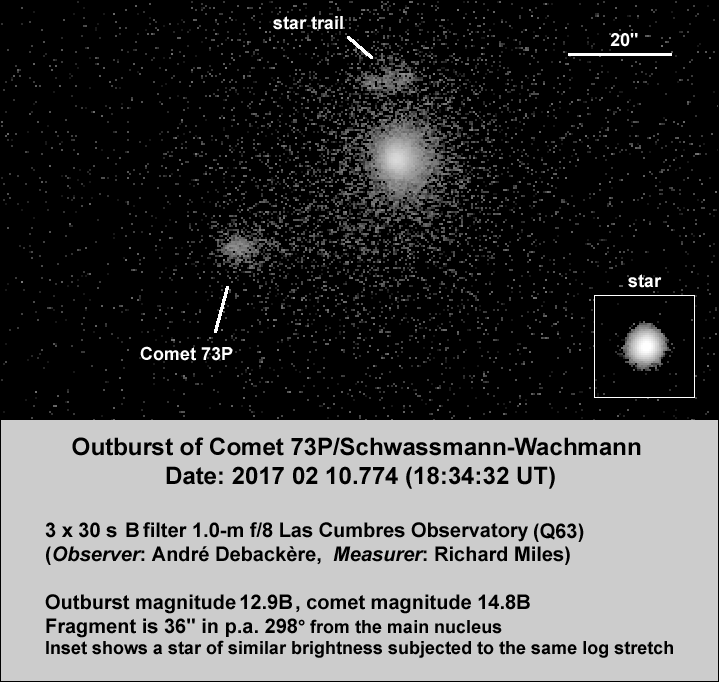2017 February 11
Bright outburst of Comet 73P fragment
Thierry Noel has reported that Comet 73P/Schwassmann-Wachmann is showing a second component in images taken remotely from Chile (Observers: A. Maury, B. Sandness, T. Noel). Follow-up images taken by Andre Debackere using the Las Cumbres Observatory 1.0-m telescope at Siding Spring, Australia and measured by Richard Miles show that the main comet is accompanied by a much brighter secondary component surrounded by a faint coma.

The above image was taken through a B filter which shows light emitted by ionized gases. Note that there appears to be a considerable extended coma visible around 20-25″ in diameter centered on the new bright source. This suggests that the outburst took place several days earlier than the date of this image since the gas travels faster than any emitted dust. It will be important to monitor the expanding dust cloud (using an R or Sloan-r’ filter) over the coming days. One difficulty for observers however is that Comet 73P is currently located well south of the celestial equator and, being at a solar elongation of just 50 degrees, is only visible shortly before dawn as seen from the southern hemisphere.
Here are corresponding measurements in Minor Planet Center report format:
COD Q63
OBS A. Debackere
MEA R. Miles
COM Johnson B filter
TEL 1.0-m f/8.0 Ritchey-Chretien + CCD
ACK MPCReport file updated 2017.02.11 10:39:39
AC2 rmiles@baa.u-net.com
NET UCAC-4
0073P C2017 02 10.77317 18 07 23.72 -20 05 16.4 15.4 N Q63
0073P C2017 02 10.77399 18 07 24.20 -20 05 16.4 15.4 N Q63
0073P C2017 02 10.77481 18 07 24.33 -20 05 17.3 15.0 N Q63
0073Pa C2017 02 10.77317 18 07 21.61 -20 04 59.1 13.1 N Q63
0073Pa C2017 02 10.77399 18 07 21.88 -20 04 59.3 13.3 N Q63
0073Pa C2017 02 10.77481 18 07 22.12 -20 04 59.8 13.1 N Q63
—– end —–
and here is the photometry of stacked images (20″ diameter measurement aperture):
0073P C2017 02 10.77400 18 07 24.06 -20 05 16.4 14.8 B Q63
0073Pa C2017 02 10.77400 18 07 21.85 -20 04 59.5 12.9 B Q63
| The British Astronomical Association supports amateur astronomers around the UK and the rest of the world. Find out more about the BAA or join us. |
